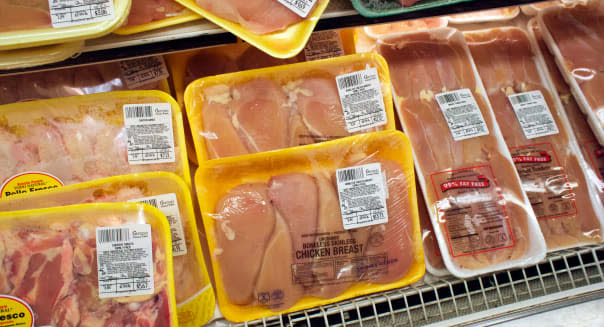USDA to Cut Back on Meat Inspections: Here's How to Protect Yourself

As last year's "pink slime" controversy suggested, America's meat supply is far from sterile. In fact, studies have shown that, depending on the cut of meat that you're looking at, more than half of the packages in your local grocery store are likely to contain harmful bacteria. And, thanks to a new government program, it looks like those numbers are set to rise.
How Meat Is Raised
To understand why meat safety is a problem, it helps to look at how meat is grown and processed. Factory farms, where most meat come from, force animals into very close quarters, where they can pick up bacteria and diseases from each other. Once the animals are slaughtered, things get even worse, as sloppy factory slaughtering often releases digestive bacteria, which is usually safely contained in an animal's abdomen. These bacteria can then find their way from the colon, to the meat, to the plate -- where they can infect consumers.
To some extent, the problem is mitigated by a variety of chemicals. On the farm end, meat processors pump their live animals full of antibiotics to keep them relatively healthy -- in fact, 80 percent of the antibiotics used in America go into healthy animals. Later, after the livestock is slaughtered, processors bathe potentially tainted meat in chlorine and ammonia to kill harmful bacteria.
But even with all those chemicals, bacteria still slips through. According to a Consumer Reports analysis released earlier this year, 90 percent of ground turkey contains at least one type of food poisoning-related bacteria, and 69 percent contains fecal-related bacteria. And beef isn't much better: A government study last year found that 55 percent of ground beef contains at least one kind of antibiotic-resistant bacteria.
A New Solution ... Or a Bigger Problem?
Chemicals aside, meat inspectors are one of the strongest barriers standing between consumers and the emergency room. But a new government program will cut the number of meat inspectors in poultry and pork plants. The program, called the Hazard Analysis and Critical Control Point-Based Inspection Models Project, aka HIMP, takes slightly different forms at different plants.
On the poultry side of things, HIMP would cut the number of inspectors, but increase the use of antimicrobial sprays to control bacteria. Based on a pilot program, the USDA claims that this change would make poultry safer, but the Government Accountability Office doesn't agree:
Sponsored Links
It criticized the USDA's findings, noting that the agency didn't "thoroughly evaluate the performance of each of its pilot projects over time, even though the agency stated it would do so." But if the health outcome of the new program is in question, the economic outcome is not: the reduced inspections would cut $30 million from the federal budget ... and would save poultry producers $256 million per year.
The pork version of HIMP is a little different. Instead of replacing government inspectors with antimicrobial sprays, the USDA's proposed rules would allow plants to replace government inspectors with company employees. This, too, has already been tested in a pilot program -- and has also been criticized by the GAO. Little wonder: Three of the five U.S. plants that took part in the pilot program have been cited as among the worst in the country when it comes to health and safety violations. Meanwhile, the USDA has also allowed overseas plants in Canada and Australia to test the new procedures, with similar results. In 2012, the Canadian plants using the program had to recall 8.8 million pounds of E. Coli-tainted beef, and 11 shipments from Australian plants using the program were stopped at U.S. ports because of contamination.
The USDA has agreed to conduct another study by March, after which it hopes to roll out HIMP to all American pork processing plants.
What Can You Do?
Even if HIMP isn't approved, buying and cooking meat is still a mildly dicey proposition. Still, there are a few things you can do:
You can buy organic meat, which has far fewer antibiotic-resistant pathogens than factory meat. As an added plus, it also isn't laden with artificial growth hormones, which could also have an impact on your health.
You can try to buy from safe processors. Your local butcher might be able to tell you where your meat came from and how it was processed. Alternately, you might try Costco, which charges less for most meats and is careful to label all of its mechanically tenderized products. (For an explanation of why mechanical tenderization is a hazard, look at this article).
To be really safe, you should cook your meat to an internal temperature of 160º F. In the case of burgers and steaks, this could be a bummer: After all, nobody likes to eat a hockey puck. But with some other cuts, like ribs, brisket, pot roast, and stew beef, slow cooking can break down the collagen in your meat, making it tender and delicious. As an added plus, these cuts tend to be among the cheapest ones in your butcher case!
Meat safety isn't merely something you should think about in the home: Some of the country's most famous chain restaurants, including Red Robin (RRGB), Applebees (DIN), and Outback Steakhouse (BLMN) have been cited for food poisoning outbreaks. If you're eating at a chain restaurant, don't be afraid to ask where your steak came from. And, if they don't know, you might think about switching from sirloin to pot roast.
Bruce Watson is DailyFinance's Savings editor. You can reach him by e-mail at bruce.watson@teamaol.com, or follow him on Twitter at @bruce1971.
%Gallery-158704%

